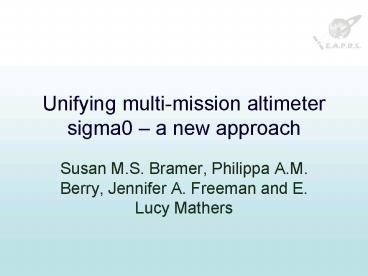Unifying multimission altimeter sigma0 a new approach
1 / 20
Title:
Unifying multimission altimeter sigma0 a new approach
Description:
To cross calibrate altimeter sigma0 over ocean co-temporal, co-spatial data required. ... Altimeter return waveforms over land do not conform to Brown Model' ... –
Number of Views:36
Avg rating:3.0/5.0
Title: Unifying multimission altimeter sigma0 a new approach
1
Unifying multi-mission altimeter sigma0 a new
approach
- Susan M.S. Bramer, Philippa A.M. Berry, Jennifer
A. Freeman and E. Lucy Mathers
2
Contents
- Introduction
- Expert system
- Finding natural land calibration targets
- Modelling calibration zones with ERS-1 GM
- Cross-calibration of ERS-1/2 and Envisat sigma0
- Automation of model creation
- Cross-calibration with TRMM
- Jason data - first results
- Future - building a TOPEX model
3
Introduction
- To cross calibrate altimeter sigma0 over ocean
co-temporal, co-spatial data required. - This is not always possible
- Another approach is to use natural land
calibration targets to cross calibrate. - In order to do this detailed sigma0 models of the
land calibration targets must be created.
4
Introduction
- Detailed sigma0 modelling is required over land
because sigma0 response varies widely over land,
even over 2km dead band (Berry et al 2005). - Models manually created for 4 desert areas
(Johnson 2002). - Echo shapes complex and highly variable over
land. Use expert system approach to analyse and
classify individual echoes.
5
Expert System
- Altimeter return waveforms over land do not
conform to Brown Model - Expert System interprets complex waveforms and
chooses suitable retracker.
6
Model Creation
- Global search undertaken for regions stable in
sigma0 response. - Requirement sigma0 values near crossovers vary
by less than 1dB. - As Geodetic Mission tracks time separated, only
areas with little environmental contamination
appear coherent when plotted. - Detailed Crossover Analysis employed.
- Model overpopulated along 35 Day Mission tracks.
7
Simpson Desert Model (Johnson 2002)
- Environmental Contamination removed manually.
- Tuned for ERS-1/2.
- We require detailed modelling of ground tracks of
other satellites, other areas. - Technique unsuitable for wetter areas.
- Mean values taken where multiples.
- Delauney Triangulation and Bilinear Interpolation
create surfaces.
8
Model Testing
- Test tracks excluded from model and compared with
predictions.
Test Track over Simpson Desert (Johnson
2002) Top red actual values, blue modelled
values. Bottom differences.
9
Model Usage
- The models were then used for cross calibration
of ERS-1/2 ice/ocean mode sigma0 (Johnson 2002). - ERS-1 to ERS-2 ice mode cross calibration offset
7.55 0.02 dB - ERS-1 Ice to Ocean mode 9.06 0.01 dB
- ERS-1 ice to ERS-2 ocean 7.24 0.14 dB
- These models have also been used to study the
validity of the Envisat SGDR values over land,
and retracked Sigma0.
10
Model Usage
Retracked Envisat Ku and S Band with Sigma0 Model
11
Model Usage
- BUT manual model building prohibitively time
consuming and subjective.
12
Automation of Model Production
- Software tools developed to enable automated
removal of environmental contamination. - Only contaminated sections of track removed.
- Crossover Analysis used to reconcile 35 day
tracks to Geodetic Mission. - Minimum values always preferred as representing
dryer conditions.
Cleaned (green) and original, environmentally
contaminated (red) 35 day repeat tracks
13
Original and New Simpson Desert Models, ERS-1/2
- New model and original have correlation
coefficient 0.935 - Original model takes mean values, new model takes
minimum. - It is not expected that new models will be quite
as smooth as old, BUT
Huge savings in time, and some data extra data
kept
14
Cross Calibration with TRMM PR
- Can we connect this modelled sigma0 to the TRMM
dataset sigma0 to prove this cross-calibration
even works between different sensors? - PR 2A21 surface Sigma0 product processed and
compared with model.
15
Cross Calibration with TRMM PR
- Correlation between altimeter and PR decreases
rapidly as PR swings away from nadir. - PR more sensitive to vegetation as moves away
from nadir. - Higher correlation is obtained over Eastern
Sahara region (less vegetation)
16
Jason/TOPEX cross calibration
- So technique works for cross-calibration.
- Wish to use for TOPEX.
- But need to overpopulate model along ground
tracks, and questions over TOPEX sigma0 mean
cannot be used. - So look to Jason-1.
17
Jason-1 land sigma0 A first look
- Some Jason-1 echoes now processed through expert
system and compared with model. - Initial results show reasonable agreement along
tracks crossing central Simpson Desert, noting
that model is reliant on GM only along Jason
tracks.
- Mean Difference from Model (7 Cycles) -3.084
- Mean difference is greater if only central
calibration zone used. - Mean Correlation Coefficient 0.772
- Standard deviation of track correlation
coefficients 0.053 - Assimilating Jason will improve the model
detailing. - Detailed statistics will be calculated prior to
assimilation into model.
18
Jason-1 land sigma0 A first look
- Jason repeat track 88 and Sigma0 model (red).
19
Next steps
- Now populating model with 1 year of Jason-1 data.
- Then will fly entire TOPEX mission over
calibration models to assess sigma0 stability,
will solve for corrections and apply over ocean,
then compare results with TOPEX GDR values.
20
Conclusion
- Cross calibration of sigma0 response of different
altimeters is very successful over natural land
targets. - In order to achieve this detailed sigma0 models
must be created. - For best results models must be over-populated
along ground tracks, hence Jason values may be
used to validate TOPEX. - Over land correlations between such differing
instruments as an altimeter and TRMM PR may also
be studied.































